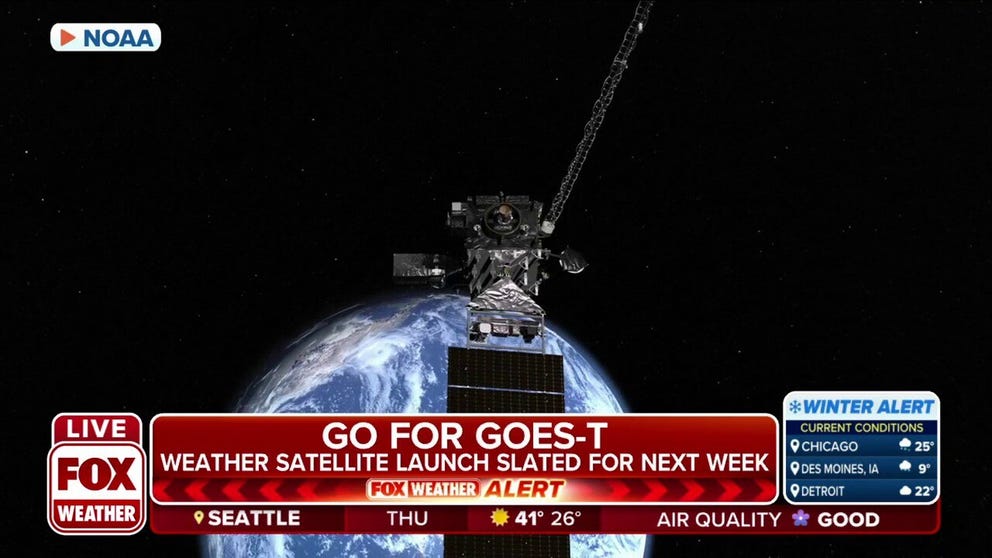How NOAA's new GOES spacecraft will improve space weather forecasting
GOES-T instruments will provide advance warnings for space weather hazards that could disrupt communication, cause power blackouts
GOES-T weather satellite will help meteorologists in FOX Weather Forecast Center
The launch of the GOES-T weather satellite will help meteorologists in the FOX Weather Forecast Center.
Does your morning routine include checking the local forecast? What about the space forecast? Probably not, but space weather caused by solar storms can also impact your daily life, just like the weather down on Earth.
According to NOAA's Space Weather Prediction Center, there are many impacts space weather can have on everyday life, from radio communications outages to the power grid and negatively affecting satellites orbiting Earth that you use for GPS or other services.
NOAA and NASA's newest weather-monitoring satellite GOES-T set to launch from Florida on March 1, will track wildfires and provide advance warning for severe weather. It will also improve space weather forecasting, giving warnings of incoming geomagnetic storms.
While solar flares also cause beautiful phenomena like the Northern Lights, the same flares can knock out satellite communication or even create drag, causing the spacecraft to pull closer to Earth.
BEFORE NOAA SATELLITES CAN IMPROVE WEATHER FORECASTS, HERE'S WHERE THEY ARE BUILT
Most recently, SpaceX lost nearly all the Starlink internet satellites it launched after a geomagnetic storm hit. These space weather events are created by solar flares and cause Earth's atmosphere to warm and density to increase at the altitude where some satellites fly.
After the geomagnetic storm hit, the Starlink team commanded the satellites into safe mode to minimize the drag and "take cover from the storm," but still, SpaceX lost 40 out of 49 satellites due to the increased drag.
"These storms cause the atmosphere to warm and the atmospheric density at our low deployment altitudes to increase," said SpaceX in a statement. The difference in drag is similar to walking through air and walking in water.
"The escalation speed and severity of the storm caused atmospheric drag to increase up to 50% higher than previous launches," SpaceX continued.
'IT SAVES LIVES': GEOSTATIONARY LIGHTNING MAPPER CRUCIAL FEATURE FOR GOES SERIES
GOES-T has a suite of instruments that will detect and provide advance warnings for space weather hazards that could disrupt communication and navigation satellites and cause power blackouts.
Two of the instruments point directly at the sun to measure solar rays.

NOAA’s Geostationary Operational Environmental Satellite-T (GOES-T) is in view alongside its banner inside the Astrotech Space Operations facility in Titusville, Florida, on Jan. 20, 2022. GOES-T is scheduled to launch on March 1, 2022, atop a United Launch Alliance (ULA) Atlas V 541 rocket from Space Launch Complex 41 at Cape Canaveral Space Force Station.Credits: NASA/Ben Smegelsky
The Solar Ultraviolet Imager (SUVI) telescope looks at extreme ultraviolet wavelengths. It looks for active sun areas that could emit solar flares or solar filaments that may give off a coronal mass ejection. Knowing when these solar events happen will help provide early warning on Earth.
The Extreme Ultraviolet and X-ray irradiance sensors (EXIS) detect solar flares and monitor the impacts of those flares on the upper atmosphere. The X-ray sensor will alert NOAA when flares are strong enough to cause blackouts, while the extreme ultraviolet sensor measures changes in Earth's ionosphere from large solar flares.
Two other instruments will be looking closely at the near-Earth space environment.
GOES-T SATELLITE ARRIVES AT KENNEDY SPACE CENTER IN PREPARATION FOR LAUNCH
The Space Environment In-Situ Suite (SEISS) has four sensors that monitor energetic particles surrounding Earth. The Magnetometer monitor measures changes to the magnetosphere that could be dangerous to spacecraft or astronauts in space. For example, NASA has to consider radiation from solar storms to determine if it will be safe for astronauts to spacewalk outside the International Space Station.
"Earth's magnetic field is important because the magnetic field protects us from the solar wind," Arleen Knaub, deputy program manager for GOES at Lockheed Martin said. "If the Earth's magnetic field is declining or changing, we want to know that because then the solar wind can strip away the Earth's atmosphere."
Observations from GOES-R, which will be renamed GOES-18 once in orbit, help NOAA's Space Weather Prediction Center to issue space weather forecasts.
Forecasters with the Space Force's 45th Weather Squadron in Florida provide weather data to launch providers like SpaceX and ULA before liftoff. More recently, the 45th started to include solar weather in the launch forecasts.
United Launch Alliance is preparing to launch the GOES-T satellite, the third in a series of upgraded spacecraft part of the Geostationary Operational Environmental Satellites (GOES) program. The Atlas V liftoff is scheduled for March 1 during a two-hour window opening at 4:38 p.m. from Cape Canaveral Space Force Station.
